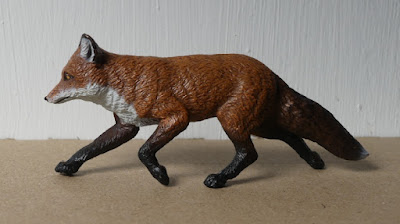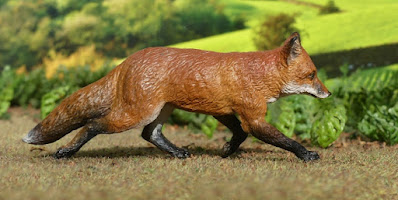The red fox has been one of my favourite animals since childhood, rare sightings of a quick bright animal dashing away, and starring in some of my favourite wild-animal-themed books, including Colin Dann's Farthing Wood series. In that pre-internet era of library books and buying wildlife magazines when they had the right animal on the cover, I read everything I could find about foxes!
Later, when I had my first job, I got to meet and make almost-friends with the foxes which called the same farm home. The adults got used to me, and would calmly glance up and wander off rather than running, and later in each summer, bring their babies into the paddocks to play in broad daylight, while I worked on weeding, or watched them alongside the horses. And when I stayed there overnight to mind the place while the owner was away, I'd wait up in the evenings (in the conservatory with the lights off) to watch the foxes hunting and interacting, all round the yard and fields I could see from where I sat.
A couple of weeks ago, I watched a really good red fox documentary on tv, and that was the final push which inspired me to buy a model to paint. After a couple of quick Ebay orders - one for the fox himself, one for some paints in appropriately gingery colours - I was ready to have a go!
And here he is! I'm very pleased with how he turned out, considering this was a bit of an experimental venture into a whole new order of mammals!
I tried to give his coat as much variety in shading as I could, without going too exaggerated as I wanted him to be an 'average' kind of fox colour, a typical mid-reddish shade, rather than the very grey-backed, or very black-tinged, individuals. This was the reference photo I used, for the front half shading especially, and applying white in the right places, but deliberately didn't include so much of the blond/black on his back half, just to keep him more like the foxes I used to see.
This was my first time painting with some of these colours, usually I work my bright chestnutty horse colours from a very minimalist selection of one orangey brown, one burgundy, and one sandy tan, but to bring out the redder and more gingery fox colours, I had to buy a deep orange, a bright golden brown, and a paler reddish brown, too. The three extra paints cost more than the Papo fox did!
His other side - I find that, just as with my equine models, the fox has a 'good side' for photos and display, so this other side feels very much like the back of him - I think it's the position of his legs which does it.
I love his long, low running pose - you can just imagine him making his way along the edge of a field keeping by the hedge, or using a grass track between standing crops.
This Papo sculpt reminds me most of the foxes I see here in the UK; a lot of model brands seem to be based on photos of American or far-northern-European foxes, very thick-winter-coat fluffy and looking short and stocky in the leg and neck, where our locals have a shorter coat, a longer leaner more athletic look.
Not a great picture but here's a view of the white markings underneath, and how they wrap round the limbs - a lot more complicated than just the white neck and chest his original paintjob had. The white underside, and the black leg/ear colour, do vary hugely from fox to fox, with some having entirely red legs with no dark points, and others somewhere in between. They can also have a dark or white tail tip. I copied the markings on mine from that good clear reference picture, apart from the tail tip, which I made whiter because I really do remember seeing that feature clearly on the foxes I used to watch at work.
With my model horse customs, the last part of creating them is usually to think of a name, so it makes a refreshing change to do a wild animal, who doesn't need one!








What a lovely sculpt! I agree, it's so rare to find our more familiar skinny foxes in model form, they're always extra floofy!
ReplyDeleteI think most collectors would favour native-species models which look like their familiar local ones, and the same must go for the designers at each company - so Schleich foxes aim to look like German ones, and Breyer copy American ones, and so on.
DeleteI can't find any actual confirmation that continental-europe foxes ARE physically different to ours, but I've always thought they look different, when seeing them in photos or nature programmes, so I reckon it must be a coat thing - colder weather, fluffier foxes?
But I did find this page with a good thorough description of American vs European fox populations, which is a long but interesting read : https://www.wildlifeonline.me.uk/questions/answer/are-north-american-and-european-red-foxes-different-species